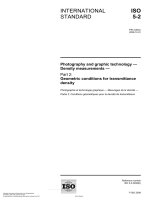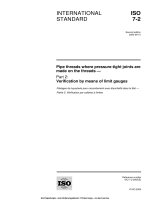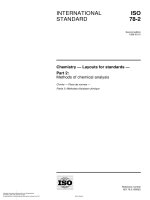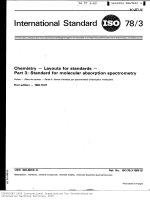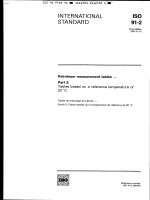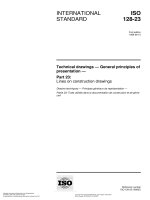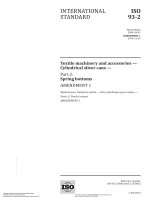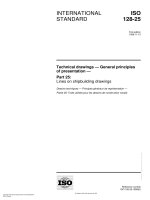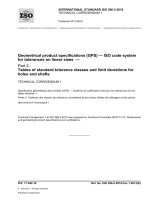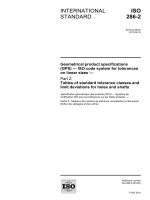Tiêu chuẩn iso 00078 2 1999
Bạn đang xem bản rút gọn của tài liệu. Xem và tải ngay bản đầy đủ của tài liệu tại đây (84.98 KB, 24 trang )
INTERNATIONAL
STANDARD
ISO
78-2
Second edition
1999-03-01
Chemistry — Layouts for standards —
Part 2:
Methods of chemical analysis
Chimie — Plans de normes —
Partie 2: Méthodes d'analyse chimique
--`,,```,,,,````-`-`,,`,,
Copyright International Organization for Standardization
Provided by IHS under license with ISO
No reproduction or networking permitted without license from IHS
A
Reference number
ISO 78-2:1999(E)
Not for Resale
ISO 78-2:1999(E)
ISO (the International Organization for Standardization) is a worldwide federation of national standards bodies (ISO
member bodies). The work of preparing International Standards is normally carried out through ISO technical
committees. Each member body interested in a subject for which a technical committee has been established has
the right to be represented on that committee. International organizations, governmental and non-governmental, in
liaison with ISO, also take part in the work. ISO collaborates closely with the International Electrotechnical
Commission (IEC) on all matters of electrotechnical standardization.
International Standards are drafted in accordance with the rules given in the ISO/IEC Directives, Part 3.
Draft International Standards adopted by the technical committees are circulated to the member bodies for voting.
Publication as an International Standard requires approval by at least 75 % of the member bodies casting a vote.
International Standard ISO 78-2 was prepared by Technical Committee ISO/TC 47, Chemistry, Subcommittee SC 1,
General methods.
This second edition cancels and replaces the first edition (ISO 78-2:1982), which has been revised to reflect
changes in Part 3 of the ISO/IEC Directives.
ISO 78 consists of the following parts, under the general title Chemistry — Layouts for standards:
Part 2: Methods of chemical analysis
Part 3: Standard for molecular absorption spectrometry
Part 4: Standard for atomic absorption spectrometric analysis
NOTE
Part 1 was planned but never published.
Annex A forms an integral part of this part of ISO 78. Annexes B and C are for information only.
© ISO 1999
All rights reserved. Unless otherwise specified, no part of this publication may be reproduced or utilized in any form or by any means, electronic
or mechanical, including photocopying and microfilm, without permission in writing from the publisher.
International Organization for Standardization
Case postale 56 • CH-1211 Genève 20 • Switzerland
Internet
Printed in Switzerland
ii
Copyright International Organization for Standardization
Provided by IHS under license with ISO
No reproduction or networking permitted without license from IHS
Not for Resale
--`,,```,,,,````-`-`,,`,,`,`,,`---
Foreword
©
ISO
ISO 78-2:1999(E)
Introduction
It is recommended that standards for methods of chemical analysis are drawn up in accordance with Part 3 of the
ISO/IEC Directives for the technical work of ISO, which gives general guidance, and using the layout of which
details are given on the following pages.
It should always be remembered, in making use of this layout, that it is for guidance only. It should be adapted to
suit any special requirements. There may be no need for all the subdivisions provided: those not required should be
disregarded.
With the object of helping to solve problems of drafting and layout which arise in drawing up standards for methods
of chemical analysis, ISO/TC 47 has established a series of standard layouts:
layout for a standard method of chemical analysis, with notes on its application (ISO 78-2);
standard layouts for instrumental analyses, with notes on their application (ISO 78-3 and ISO 78-4).
A standard for a chemical product should form a consistent whole. In addition to specifying the characteristics
required of the product, it should state how to determine these characteristics. A standard method of chemical
analysis (test method) may be incorporated in the text of a standard for a chemical product. Test methods may be
presented as separate clauses, as annexes or as separate parts. However, a test method will normally be issued as
a separate standard if it is likely to be referred to in a number of other standards. This will shorten the text of the
standard for the chemical product; and, if a general method of chemical analysis applicable to the product exists,
the standard for the product may merely refer to it.
The adoption of a standard form of layout and drafting ensures:
that no important point is overlooked in the preparation of the standard;
that the various items of information to be included in the standard are always given in the same order;
that any desired clause may be found rapidly, whatever the origin or scope of the standard (this is particularly
important if part of the text is being translated or two texts are being compared);
simplification, rationalization and standardization of methods, reagents and equipment used in test laboratories;
that each International Standard or other international document prepared in this field is drafted in terms which
are as clear as possible.
--`,,```,,,,````-`-`,,`,,`,`,,`---
Copyright International Organization for Standardization
Provided by IHS under license with ISO
No reproduction or networking permitted without license from IHS
iii
Not for Resale
--`,,```,,,,````-`-`,,`,,`,`,,`---
Copyright International Organization for Standardization
Provided by IHS under license with ISO
No reproduction or networking permitted without license from IHS
Not for Resale
INTERNATIONAL STANDARD
ISO 78-2:1999(E)
© ISO
Chemistry — Layouts for standards —
Part 2:
Methods of chemical analysis
1 Scope
This part of ISO 78 sets out a number of principles applicable to the layout and wording of methods of chemical
analysis described in International Standards. It may also be useful for other test methods.
2 Normative references
The following normative documents contain provisions which, through reference in this text, constitute provisions of
this part of ISO 78. For dated references, subsequent amendments to, or revisions of, any of these publications do
not apply. However, parties to agreements based on this part of ISO 78 are encouraged to investigate the possibility
of applying the most recent editions of the normative documents indicated below. For undated references, the latest
edition of the normative document referred to applies. Members of ISO and IEC maintain registers of currently valid
International Standards
ISO 31 (all parts), Quantities and units.
ISO 1000, SI units and recommendations for the use of their multiples and of certain other units.
ISO 5725 (all parts), Accuracy (trueness and precision) of measurement methods and results.
3 Terms and definitions
For the purposes of this part of ISO 78, the following definitions apply:
3.1
laboratory sample
sample as prepared for sending to the laboratory and intended for inspection or testing
[Based on ISO 6206]
3.2
test sample
sample prepared from the laboratory sample and from which test portions will be taken
[Based on ISO 6206]
3.3
test portion
the quantity of material drawn from the test sample (or from the laboratory sample if both are the same) and on
which the test or observation is actually carried out
[Based on ISO 6206]
--`,,```,,,,````-`-`,,`,,`,`,,`---
Copyright International Organization for Standardization
Provided by IHS under license with ISO
No reproduction or networking permitted without license from IHS
1
Not for Resale
ISO 78-2:1999(E)
©
ISO
3.4
standard volumetric solution
solution for titrimetric analysis, the concentration of which is known accurately
3.5
standard reference solution
solution used as a reference solution for calibrating other solutions
NOTE 1
It is either prepared from a primary standard or calibrated by some other means.
NOTE 2
Many standard reference solutions which can be used to prepare standard solutions are commercially available.
3.6
standard solution
solution of accurately known concentration of an element, an ion, a compound or a group derived from the
substance used for its preparation
3.7
standard matching solution
solution of which the relevant characteristic is known or defined (for example colour, turbidity) and is used to assess
the test solution in relation to that characteristic
NOTE 2
It may be prepared from solutions mentioned above or other solutions having the required characteristic.
NOTE 3
A.13.7).
The method of preparation of standard matching solutions is normally given in the subclause “Calibration” (see
3.8
precision
the closeness of agreement between independent test results obtained under stipulated conditions
[Based on ISO 5725-1]
3.9
accuracy
closeness of agreement between a test result and an accepted reference value
NOTE
The term accuracy, when applied to a set of test results, involves a combination of random components and a
common systematic error or bias component.
[Based on ISO 5725-1]
3.10
repeatability
precision under repeatability conditions
[Based on ISO 5725-1]
3.11
repeatability conditions
conditions where independent test results are obtained with the same method on identical test items in the same
laboratory by the same operator using the same equipment within short intervals of time
[Based on ISO 5725-1]
2
Copyright International Organization for Standardization
Provided by IHS under license with ISO
No reproduction or networking permitted without license from IHS
Not for Resale
--`,,```,,,,````-`-`,,`,,`,`,,`---
NOTE 1 The English term standard matching solution is used solely as a generic term for these solutions, and each solution
is normally defined more precisely by the appropriate adjective (for example, “standard colorimetric solution”, “standard
turbidimetric solution”).
©
ISO
ISO 78-2:1999(E)
3.12
repeatability limit
value less than or equal to which the absolute difference between two test results obtained under repeatability
conditions may be expected to be with a probability of 95 %
NOTE
The symbol used is r.
[Based on ISO 5725-1]
3.13
reproducibility
precision under reproducibility conditions
[Based on ISO 5725-1]
3.14
reproducibility conditions
conditions where test results are obtained with the same method on identical test items in different laboratories with
different operators using different equipment
[Based on ISO 5725-1]
NOTE
--`,,```,,,,````-`-`,,`,,`,`,,`---
3.15
reproducibility limit
the value less than or equal to which the absolute difference between two test results obtained under reproducibility
conditions may be expected to be with a probability of 95 %
The symbol used is R.
[Based on ISO 5725-1]
4 Quantities, units and symbols
4.1 General
The quantities, units, mathematical signs and symbols for quantities laid down in ISO 31 (all parts) and ISO 1000
shall be used wherever possible.
The symbols for units of measurement shall be used if they are preceded by a number expressed in figures. In
other cases, these units should preferably be written out in full, except where used in drawings, graphs and in
column headings in tables.
NOTE
In some countries, the symbol °/oo (“per mill” or “per thousand”) is used for the number 0,001. This symbol should
preferably be avoided.
Since per cent and per mill are numbers, it is in principle meaningless to speak about percentage by mass or
percentage by volume. Additional information, such as % (m/m) or % (V/V) should preferably not be attached to the
unit symbol therefore. The preferred way of expressing a mass or volume fraction is: “the mass (or volume) fraction
is 0,75” or “the mass (or volume) fraction is 75 %”. Mass and volume fractions can also be expressed in the form
5 µg/g and 4,2 ml/m3 respectively. Abbreviations such as ppm, pphm and ppb shall not be used.
4.2 Choice of test methods
As far as possible, the same test methods for a given property or characteristic of related chemical products shall
be adopted in all ISO documents, and their wording shall be as similar as possible. This does not apply to certain
industries if, in a particular industry, this rule would be contrary to justified and well established practice which it is
desirable to retain.
Copyright International Organization for Standardization
Provided by IHS under license with ISO
No reproduction or networking permitted without license from IHS
3
Not for Resale
ISO 78-2:1999(E)
©
ISO
4.3 Chemical nomenclature
The recommendations prepared by the International Union of Pure and Applied Chemistry (IUPAC) on the
nomenclature of chemicals of high purity and the way of spelling and printing their names should preferably be
applied, e.g. the IUPAC nomenclature for organic compounds. If they exist, Chemical Abstract Registry Service
Numbers (CAS numbers) should be given (see clause A.10). It is advisable to put the trivial name of the reagent in
parentheses after the IUPAC name when it first occurs. In the remainder of the text, either the IUPAC name or the
trivial name may be used, but the same name shall be used consistently throughout the remainder of the text.
The use of trade/proprietary names shall be avoided as far as possible, even if they are in common use.
For commercial chemicals (basic chemicals for industrial use), the trivial name should be given in the title of the
standard and in the “Scope” clause of the standard; the corresponding IUPAC name for the pure product should be
given in parentheses after the trivial name, but thereafter only the trivial name need be used.
The use of symbols for chemical products shall be restricted to chemical formulae and to symbols used to indicate
quantities, e.g. c(H2SO4). In running text, the full names shall be used.
4.4 Numerical values and tolerances
Whenever a quantity, for example a temperature or a period of time, is expressed, a tolerance on its value shall be
specified where it is critical.
5 Clause titles and clause order
The preferred titles of the clauses (and other elements) in methods of chemical analysis, and the preferred order of
the clauses, are given below.
Any clause or subclause which is unnecessary in a particular case may be omitted, and others, if required, may be
added in the most appropriate places. The clauses and subclauses shall be numbered consecutively from the
beginning to the end of each document, using arabic numerals. Clear distinction shall be made between normative
and informative parts of the standard, such as annexes.
For further details, see the relevant clause in annex A.
Foreword
A.1
Introduction
A.2
Title
A.3
Warnings
A.4
Scope
A.5
Normative references
A.6
Definitions
A.7
Principle
A.8
Reactions
A.9
Reagents and materials
A.10
Apparatus
A.11
4
Copyright International Organization for Standardization
Provided by IHS under license with ISO
No reproduction or networking permitted without license from IHS
Not for Resale
--`,,```,,,,````-`-`,,`,,`,`,,`---
For comments see
©
ISO
ISO 78-2:1999(E)
Sampling
A.12
Procedure
A.13
Calculation
A.14
Precision
A.15
Quality assurance and control
A.16
Special cases
A.17
Test report
A.18
Annexes
A.19
Bibliography
A.20
--`,,```,,,,````-`-`,,`,,`,`,,`---
Copyright International Organization for Standardization
Provided by IHS under license with ISO
No reproduction or networking permitted without license from IHS
5
Not for Resale
ISO 78-2:1999(E)
©
ISO
Annex A
(normative)
Notes on the application of the layout for a standard method of chemical
analysis
A.1 Foreword
Where applicable, the main changes compared with the previous edition and the titles of all the parts of a multipart
standard shall be given in addition to the standard text.
A.2 Introduction
The introduction is an optional element used, if necessary, to present additional information, such as comments
concerning the technical content of the standard or the reasons for its preparation.
If background information on the method is required, it should preferably be included in this clause.
A.3 Title
The title of the standard shall express concisely and without ambiguity the products to which the test method
applies, the constituent or the characteristic to be determined and the nature of the determination. It should be
limited, wherever possible, to a maximum of three elements.
EXAMPLE 1 Light olefins for industrial use — Determination of traces of chloride — Wickbold combustion method
EXAMPLE 2 Liquid chemical products for industrial use — Determination of density at 20 °C
A.4 Warnings
If the product being analysed or the reagents or the procedure are dangerous, either to health or to the
environment, it is essential to draw attention to the hazards and to describe the precautions necessary to avoid
them. This information shall be printed in bold type and placed
immediately after the title of the standard if the danger is of a general nature or is due to the product being
analysed;
after the name of the reagent or material if the danger is due to a particular reagent or material;
at the beginning of the “Procedure” clause if the danger is inherent in the procedure (see also A.13.1).
EXAMPLE
WARNING — Persons using this International Standard should be familiar with normal laboratory practice. This
standard does not purport to address all of the safety problems, if any, associated with its use. It is the responsibility
of the user to establish appropriate safety and health practices and to ensure compliance with any national regulatory
conditions.
--`,,```,,,,````-`-`,,`,,`,`,,`---
6
Copyright International
Organization for Standardization
Provided by IHS under license with ISO
No reproduction or networking permitted without license from IHS
Not for Resale
©
ISO
ISO 78-2:1999(E)
A.5 Scope
This clause of the standard shall state succinctly the method of chemical analysis and specifically the products to
which it applies. If applicable, it shall state the detection limit and/or the limit beyond which the method can no
longer be assumed to be quantitative.
It shall contain any additional, useful, information which could not be included in the title.
It shall also contain sufficient information to enable the user to judge quickly whether the standard is applicable to
the products being considered, or whether limitations exist. These limitations shall take into account the presence of
other components of the product or products in question and of their limiting contents.
Relevant information regarding possible interference applicable to the method, wherever such data are available,
shall also be included in this clause. If it is necessary to provide modifications to the basic method, for instance to
ensure the elimination of certain interfering factors, these modifications should preferably be treated as special
cases. These special cases shall be indicated in the “Scope” clause and the corresponding modifications shall be
described in the “Special cases” clause (see clause A.17).
It is sometimes necessary to provide several methods for the determination of a given entity, depending, for
example, on the composition of the product or on its differing contents for that entity, or the accuracy required, each
method having its own particular scope. A clear distinction shall be drawn between the individual scopes of the
methods laid down if the standard includes several methods.
A.6 Normative references
This clause shall give a list of those documents which are necessary for the application of the International
Standard.
Documents which have merely served as references in the preparation of the standard shall be indicated in a
bibliography at the end of the document.
A.7 Definitions
This clause shall give any definitions of terms used in the text that may be necessary for its complete
understanding. It is recommended that reference be made to already existing definitions and/or terminology
standards wherever possible.
A.8 Principle
This optional clause indicates the essential steps in the method used, the basic principles and the properties of
which use is made and, if appropriate, the reasons justifying the choice of certain procedures.
A.9 Reactions
This clause shall indicate the essential reactions, if they are considered necessary for the comprehension of the text
or the calculations. These reactions shall, if appropriate, be expressed in ionic form.
The reactions are given for guidance only and are not intended to settle any controversial questions. They justify the
calculations made from the data obtained in the determinations and may lead to a better understanding of the
method, especially if several successive changes occur in the state of oxidation of the element being determined.
Copyright International Organization for Standardization
Provided by IHS under license with ISO
No reproduction or networking permitted without license from IHS
7
Not for Resale
--`,,```,,,,````-`-`,,`,,`,`,,`---
The “Scope” clause should preferably be written in such a way that it is suitable for use as a summary for indexing
or information purposes.
ISO 78-2:1999(E)
©
ISO
When titrations are involved, they are particularly useful in indicating the number of equivalents in each mole of
reactant.
A.10 Reagents and materials
A.10.1 General
The title of this clause shall be “Reagents” or “Materials” or “Reagents and materials”, as appropriate. This clause
shall begin, if applicable, with the following sentence (or a suitably modified version of it):
“During the analysis, unless otherwise stated, use only reagents of recognized analytical grade and distilled or
demineralized water or water of equivalent purity.”
When it is necessary to specify the grade of water in accordance with ISO 3696, use the following wording:
“Use only reagents of recognized analytical grade, unless otherwise specified.
5.1 Water, complying with grade x as defined in ISO 3696.”
This clause shall list all the reagents and materials used during the test, together with their essential characteristics
(concentration, density, etc.), and shall specify, if necessary, their degree of purity. If they exist, Chemical Abstract
Service Registry numbers (CAS numbers) should preferably be given. The list shall not include products used only
in the preparation of a reagent, unless the products are used several times.
If necessary, the precautions to be taken for storing the reagents, and the time for which they may be stored, shall
be specified.
If a standard volumetric solution or other standard solution is called for, its preparation and, if necessary, its
standardization shall be described in this clause. In other cases, these particulars are not necessary but, if general
methods for the preparation and checking of certain reagents used are the subject of an International Standard, a
reference to the latter shall be made.
If the absence of an interfering component in the reagents has to be verified, the details of the tests to be used for
this purpose shall be given.
It is desirable to draw up the clause in the following order:
products (excluding solutions) used in their commercially available form;
solutions or suspensions (excluding standard volumetric solutions and standard solutions), with their
approximate concentrations stated;
standard volumetric solutions and standard solutions;
indicators;
auxiliary materials (drying agents, etc.).
A.10.2 Products used in their commercially available form
In the list of reagents and materials, products used in their commercially available form shall be described
unambiguously, giving the particulars necessary for their identification (for example, the chemical name, the
chemical formula, the concentration, the CAS number) and, for solid products in particular, the presence of any
water of crystallization.
8
Copyright International Organization for Standardization
Provided by IHS under license with ISO
No reproduction or networking permitted without license from IHS
Not for Resale
--`,,```,,,,````-`-`,,`,,`,`,,`---
The reagents and materials shall be identified by a (sequential) reference number. By giving this number, in
parentheses, in the “Procedure” clause after the name of the reagent or material, repetition of the characteristics of
the reagent or material in question can be avoided and thus the text can be kept short. It is not necessary, however,
to repeat the reference number every time if no ambiguity is introduced.
©
ISO
ISO 78-2:1999(E)
A.10.3 Aqueous solutions
In the list of reagents and materials, solutions for which the solvent is not specified are aqueous by convention. The
use of the term “aqueous” in the list is superfluous.
A.10.4 Solutions of defined concentration
A.10.4.1 General
The following terms shall be used in English and French (F) (for definitions, see clause 3):
A.10.4.1.1 Standard volumetric solution
F: Solution titrée
The concentrations of such solutions shall be expressed as amount-of-substance concentrations with the unit moles
per litre (mol/l) or moles per cubic metre (mol/m3).
The numerical value of the concentration shall be represented either by a whole number (for example, 1 mol/l,
2 mol/m3) or by a decimal number (for example, 0,1 mol/l, 0,06 mol/m3). The symbol used is c [for example,
c(CuSO4) = 0,1 mol/l].
A.10.4.1.2 Standard reference solution
F: Solution étalon de référence
The concentrations of such solutions shall be expressed in the same way as those of standard volumetric solutions
(see A.10.4.1.1).
--`,,```,,,,````-`-`,,`,,`,`,,`---
A.10.4.1.3 Standard solution
F: Solution étalon
The concentrations of such solutions shall be expressed in grams per litre or a submultiple thereof.
A.10.4.1.4 Standard matching solution
F: Solution témoin
The concentrations of such solutions shall be expressed in the way indicated in A.10.4.1.1, A.10.4.1.2 or A.10.4.1.3.
A.10.4.2 Other solutions
A.10.4.2.1 If the concentration of a solution is given as a mass fraction or volume fraction, it shall be expressed in
milligrams per kilogram (mg/kg), grams per gram (g/g), millilitres per litre (ml/l) or a submultiple thereof.
A.10.4.2.2 If the concentration is given as a mass concentration, it shall be expressed in grams per litre (g/l) or a
submultiple thereof.
A.10.4.2.3 If a solution is prepared by dilution of another specified solution, the following conventions shall be
observed:
the instruction “dilute V1 → V2” means that the volume V1 of the solution specified shall be diluted to give a total
volume V2 of the final mixture;
the expression “V1 + V2” means that the volume V1 of the solution in question is/has been added to the volume
V2 of the solvent.
Expressions such as “V1:V2” or “V1/V2” which have different meanings in different countries shall not be used.
In the same way, traditionally or conventionally used denominations of solutions other than those given above (for
example “hydrogen peroxide, 12 volumes”) shall not be used.
Copyright International Organization for Standardization
Provided by IHS under license with ISO
No reproduction or networking permitted without license from IHS
9
Not for Resale
ISO 78-2:1999(E)
©
ISO
A.11 Apparatus
This clause shall list the names and significant characteristics of all the apparatus and equipment, other than
ordinary laboratory apparatus, to be used during the analysis or test.
The items of apparatus shall be identified by a (sequential) reference number. By inserting this number, in
parentheses, in the “Procedure” clause after the name of the item, repetition of the characteristics of the apparatus
in question can be avoided and thus the text can be kept short. It is not necessary, however, to repeat this
reference number every time if no ambiguity is introduced.
If appropriate, reference shall be made to International Standards concerning laboratory glassware and related
apparatus, or to other relevant International Standards or internationally acceptable documents.
--`,,```,,,,````-`-`,,`,,`,`,,`---
EXAMPLE
“4.1 One-mark pipette, capacity 50 ml, ISO 648 class A.”
It is advisable to illustrate special types of apparatus and to indicate the way in which they are assembled by means
of a diagram.
Any checking of the functioning of the assembled apparatus shall be described in the “Procedure” clause in a
subclause headed “Preliminary test” or “Check test” (see A.13.4).
Special requirements on any apparatus that is critical to the method shall be given in the “Apparatus” clause,
especially if they play a significant part in the procedure or if they constitute a factor in the safety, precision and/or
trueness of the method.
A.12 Sampling
A.12.1 General
The following terms shall be used in English and French (F) (for definitions, see clause 3).
A.12.1.1 Laboratory sample
F: Échantillon pour laboratoire
A.12.1.2 Test sample
F: Échantillon pour essai
A.12.1.3 Test portion
F: Prise d'essai
A.12.2 Sampling procedure
In principle, sampling for the preparation of the laboratory sample is independent of the chemical analysis as such,
and it is generally sufficient to refer informatively to the relevant standard dealing specifically with this question, or to
the corresponding clause of the product standard. If no relevant standard exists, the sampling clause may include a
sampling plan and sampling procedure, giving guidance on how to avoid alteration of the product and taking into
account the International Standards concerning the application of statistical methods.
If necessary, this clause shall also give any useful information on the sample preparation, the mass or volume of the
laboratory sample, the characteristics and material of the containers for its storage (for example type, capacity,
airtightness) and the storage conditions to be used.
A.12.3 Preparation of the test sample
The sampling clause shall give all the information necessary for the preparation of the test sample from which the
test portions will be drawn. This sample is prepared from the laboratory sample prepared as specified in A.12.2.
10
Copyright International Organization for Standardization
Provided by IHS under license with ISO
No reproduction or networking permitted without license from IHS
Not for Resale
©
ISO
ISO 78-2:1999(E)
In each case, all the steps in the preparation shall be stated (for example grinding, drying) together with appropriate
information on the required characteristics of the sample thus prepared (for example particle size distribution,
approximate mass or volume) and, if necessary, details of any containers to be used for storage (for example type,
capacity, airtightness and material) and the storage conditions themselves.
A.13 Procedure
A.13.1 General
This clause may be divided into as many subclauses as there are operations or sequences of operations to be
carried out.
Each sequence of operations shall be described unambiguously and concisely, using the imperative mood.
--`,,```,,,,````-`-`,,`,,`,`,,`---
If the number of steps in the procedure is large, it is recommended that the subclause covering each step be further
subdivided, using the point numbering system, with each element corresponding to a given operation and including
all indispensable preliminary operations.
If the method to be described is already given in another standard, the phrase “use the method specified in
ISO 12345” or “use one of the methods specified in ISO 12345” shall be used, with an indication of any modification,
if necessary.
It there are risks during the procedure (for example explosion, fire or toxicity) for which special precautions are
necessary, a cautionary statement shall be included in bold type at the beginning of the clause.
If necessary, more detailed advice on safety procedures and first-aid measures can be given in an annex.
The “Procedure” clause shall normally include the following subclauses1).
A.13.2 Test portion
This subclause shall give all the information necessary for the preparation of the test portion from the test sample
(or from the laboratory sample, if the two are the same) prepared as indicated in A.10.3. If appropriate, it shall state
the method of weighing or measuring this test portion (for example, using a weighing pipette). It shall state the mass
or volume of the test portion, the accuracy with which this has to be measured and, if necessary, any other relevant
characteristics.
This subclause shall also indicate if more than one test portion is required (this will be the case when the result is
taken as the mean of two or more determinations, for instance).
A.13.2.1 Test portion defined by mass
If the test portion is defined by a given mass, the description of it in a test method generally falls into one of the
following categories:
A.13.2.1.1 Definite amount
When a definite amount of the test sample is required to be taken, weighed with the accuracy specified, this shall be
expressed as illustrated by the following examples:
EXAMPLE 1 “m = 5 g ± 1 mg”
EXAMPLE 2 “m = (5 ± 0,001) g”
EXAMPLE 3 “Weigh, to the nearest 1 mg, 5 g of the test sample.”
1) In certain cases, other subclauses could be included specifying, for example, additional tests such as determination of moisture,
use of reference materials, etc.
Copyright International Organization for Standardization
Provided by IHS under license with ISO
No reproduction or networking permitted without license from IHS
11
Not for Resale
ISO 78-2:1999(E)
©
ISO
A.13.2.1.2 Approximate amount
When an approximate amount of the test sample is required to be taken, weighed with the accuracy specified, this
shall be expressed as illustrated by the following example:
EXAMPLE 1 “Weigh, to the nearest 1 mg, approximately 2 g of the test sample.”
The expression “weigh approximately 1,2 g of the test sample” means that the mass to be taken shall be within
10 % of the specified mass of the test portion. If a smaller tolerance is required, this shall be expressed as
illustrated by the following example:
EXAMPLE 2 ”Weigh, to the nearest 1 mg, 1,9 g to 2,1 g of the test sample.”
A.13.2.2 Test portion defined by volume
If the test portion is defined by a given volume, there are ways (A.13.2.2.1 and A.13.2.2.2) of indicating the accuracy
to which test portions are to be measured out.
A.13.2.2.1
If apparatus having a known accuracy is required to be used, the recommended way of describing the amount of
test sample to be measured out includes the reference number of the item of apparatus.
EXAMPLE
“Using a pipette (4.2), measure out 10 ml of the test solution.”
A.13.2.2.2 If no apparatus is specified, the accuracy of the measurement shall be indicated in the text of the
procedure.
EXAMPLE
“Take 10 ml ± 0,05 ml of the test solution.”
A.13.2.3 Test portion resulting from another determination
Finally, if the test portion is the product of another determination (for example, filtrate, precipitate or residue), its
origin shall be clearly identified by means of a capital letter.
EXAMPLE
“Solution A/filtrate C from the determination of calcium sulfate.”
This subclause shall indicate all the conditions for carrying out the blank test, if such a test is necessary to verify the
purity of the reagents or the cleanness of the laboratory environment and apparatus.
The blank test shall be carried out in parallel with the determination, by the same procedure, using the same
quantities of all the reagents as in the determination (except in the case of titrimetric methods, when the volumes of
the standard solutions will obviously be different), but omitting the test portion.
In certain cases, the absence of the test portion may cause the conditions of the blank test to differ from those of
the determination and interfere with the application of the method. In such cases, this subclause shall state the
modifications in the procedure that have to be used in the blank test to allow for these differences, while retaining, if
necessary, the same quantities of reagents as in the determination itself.
A.13.4 Preliminary test or check test
If it is necessary to make a preliminary check of the apparatus (for example, to check the performance
characteristics of a gas-chromatographic measurement system) or to verify the validity of the application of the
method by using a certified reference material, synthetic samples or natural products of known purity, this
subclause shall give all details necessary to carry out the check.
12
Copyright International Organization for Standardization
Provided by IHS under license with ISO
No reproduction or networking permitted without license from IHS
Not for Resale
--`,,```,,,,````-`-`,,`,,`,`,,`---
A.13.3 Blank test
©
ISO
ISO 78-2:1999(E)
A.13.5 Matching test
If it is necessary to allow for, or to eliminate, interference due to certain phenomena (for example, “background”
colour), an appropriate test shall be specified in this subclause, with all the necessary details of the procedure.
A.13.6 Determination(s) or test(s)
If appropriate, include at the beginning of the determination a statement along the lines: “Carry out the determination
in duplicate”.
Each sequence of operations shall be described accurately, using the imperative mood, and the test shall be set out
in an easily readable form in suitable subclauses and paragraphs in order to facilitate the description, the
understanding and the application of the procedure.
Should it be necessary, in the course of these operations, to retain the product resulting from one of the steps in the
procedure (for example, filtrate, precipitate or residue) for use as a test portion in a later determination, this shall be
clearly stated, and provision made for it to be given a reference symbol or letter by which it can be identified again
later when it is required in the course of the analysis.
EXAMPLE
“Keep filtrate D for the determination of the sodium content.”
A.13.7 Calibration
If the method requires any apparatus to be calibrated, this operation shall be the subject of a separate subclause
located at the most appropriate point in the “Procedure” clause. This subclause shall give all necessary details of
the operations to be carried out.
This subclause shall also include, if necessary, the frequency of calibration (in the case of batch analyses, for
instance). If the operations relating to the calibration are identical to those relating to the determination itself, or to a
part of it, then one of the two subclauses shall make reference to the other.
EXAMPLE
“Proceed as described in 9.4.3 to 9.4.9 inclusive in the 'Determination' subclause.”
A.14 Calculation
This clause shall indicate the method for calculating the result. The following shall be stated:
the units in which the result is to be expressed;
the equation used for the calculation;
the meanings of the algebraic symbols used in the equation;
the units in which the quantities are expressed;
the number of decimal places or significant figures to which the result is to be given.
The symbols of quantities shall be in accordance with ISO 31.
If a given symbol has to be used for different meanings of the same quantity, numerical subscripts (0, 1, 2, ...) shall
be added to the symbol (for example, m0, m1, m2).
EXAMPLE
Consider a titrimetric method for the determination of the alkalinity of a substance, carried out using standard
volumetric hydrochloric acid as titrant. The specified concentration of the hydrochloric acid is 0,2 mol/l.
The method of calculation is then:
Calculate the numerical value of the alkalinity wa, as KOH, in milligrams per gram, using the equation
--`,,```,,,,````-`-`,,`,,`,`,,`---
Copyright International Organization for Standardization
Provided by IHS under license with ISO
No reproduction or networking permitted without license from IHS
13
Not for Resale
ISO 78-2:1999(E)
â
wa =
ISO
V ìc ìM
m
where
V
is the numerical value of the volume, in millilitres, of hydrochloric acid [give the reference number
from the “Reagents and materials” clause] used;
c
is the numerical value of the exact concentration, in moles per litre, of the hydrochloric acid
solution;
m
is the numerical value of the mass, in grams, of the test portion;
M
is the numerical value of the molar mass, in grams per mole, of potassium hydroxide (M = 56,109).
Express the result to two decimal places.
A.15 Precision
For methods that have been subjected to interlaboratory tests, the precision data (i.e. the repeatability and
reproducibility) shall be indicated. The precision data shall be calculated, and should preferably also be published,
in accordance with the relevant part of ISO 5725 or in accordance with another suitable International Standard
(which shall be referenced).
It shall be clearly stated whether the precision values are expressed in absolute or relative terms.
Examples of recommended formats for precision clauses are given in annex B.
Additional statistical data should preferably be given in an annex, for instance as shown in annex C. For definitions
regarding precision, see clause 3 and ISO 5725-1.
A.16 Quality assurance and control
In this clause, the quality assurance and control programme shall be defined. Information about the control sample,
frequency and criteria, and the actions to be taken when a process is out of control, shall be given. The best way of
keeping a method under control is to use a control chart.
A.17 Special cases
This clause shall include any modifications to the procedure necessitated by the presence or absence of specific
components in the product to be analysed. The modifications shall already have been referred to in the “Scope”
clause. Each special case shall be given a different title.
The text of the modified procedure shall include the following subdivisions:
The principle of the modified procedure, specifying the modifications to be made to the principle of the general
procedure, or stating the principle of the new procedure.
A new sampling procedure, if modification is required to the general sampling procedure.
A new test procedure, or a statement of the modifications. If only the modifications are given, it will be
necessary to indicate the exact position of each modification in the general procedure. This is conveniently
done by indicating the last paragraph of the unmodified procedure (reproducing the last sentence or part
sentence if necessary), then giving the modification, and finally indicating the first unmodified paragraph which
follows the modification (reproducing the first sentence or part sentence if necessary).
The calculation applicable to the modified or additional procedure.
14
--`,,```,,,,````-`-`,,`,,`,`,,`---
Copyright International Organization for Standardization
Provided by IHS under license with ISO
No reproduction or networking permitted without license from IHS
Not for Resale
©
ISO
ISO 78-2:1999(E)
For the sake of clarity, a clause entitled “Special case” shall be drafted, even if the modification is only a small one,
rather than describing the modification in the “Procedure” clause.
A.18 Test report
This clause specifies which information is to be included in the test report. The clause shall require information to be
given on at least the following aspects of the test:
the sample;
the International Standard used (including its year of publication);
the method used (if the standard includes several);
the result(s), including a reference to the “Calculation” clause;
any deviations from the procedure;
any unusual features observed;
the date of the test.
EXAMPLE
“a) all information necessary for identification of the sample tested;
b)
a reference to this International Standard (ISO 12345:1998);
c)
the method used (A, B or C);
d)
the results of the test, including the results of the individual determinations and their mean, calculated as
specified in clause 8;
e)
any deviations from the procedure specified;
f)
any unusual features (anomalies) observed during the test;
g)
the date of the test.”
A.19 Annexes
Annexes may be used when it is desirable to relieve the body of the document of detailed information which can
more conveniently be presented in that form. It shall be clearly stated whether the annex is normative or informative.
For example, it is sometimes useful to have a schematic representation of the different stages of the procedure,
particularly with long procedures consisting of a large number of operations. Such a schematic representation is
most conveniently placed in an informative annex. It shall be drawn so as to separate clearly the different steps and
to group in a vertical line the sequence of operations carried out at each stage (e.g., precipitation, filtration,
treatment of residue). If a given sequence of operations ends at a particular stage, this shall be stated explicitly
(e.g., “discard the filtrate”).
A.20 Bibliography
If informative references are considered necessary, these may be given at the point in the text at which they are
referred to or, if there are several, in a bibliography at the end of the document.
NOTE
ISO 690 suggests which elements should be included in such references.
--`,,```,,,,````-`-`,,`,,`,`,,`---
Copyright International Organization for Standardization
Provided by IHS under license with ISO
No reproduction or networking permitted without license from IHS
Not for Resale
15
ISO 78-2:1999(E)
©
ISO
Annex B
(informative)
Examples of formats for precision clauses
B.1 Repeatability statements
EXAMPLE 1 (when precision is to be expected in absolute terms)
The absolute difference between two independent single test results, obtained using the same method on
identical test material in the same laboratory by the same operator using the same equipment within a short
interval of time, will not be greater than ... in more than 5 % of cases.
EXAMPLE 2 (when precision is to be expected in relative terms)
EXAMPLES 3a and 3b (when precision is to be related to the analyte concentration)
EXAMPLE 3a
The absolute difference between two independent single test results, obtained using the same method on
identical test material in the same laboratory by the same operator using the same equipment within a
short interval of time, will not exceed the repeatability limit r calculated from the following equation in more
than 5 % of cases:
Copper content in oil: r = 0,010 + 0,139 9 m
where m is the mean of the two results, expressed in milligrams per kilogram.
EXAMPLE 3b
When the values of two independent single test results, obtained using the same method on identical test
material in the same laboratory by the same operator using the same equipment within a short interval of
time, lie within the range of the mean values cited below, the absolute difference between the two test
results obtained will not exceed the repeatability limit r deduced by linear interpolation from the following
data in more than 5 % of cases:
Copper content (mg/kg):
r (mg/kg):
NOTE
0,5
0,06
5,8
0,8
35,8
3,6
These statements may be shortened as follows (using EXAMPLE 1 as an example):
The absolute difference between two independent single test results obtained under repeatability conditions will not be greater
than … in more than 5 % of cases.
16
Copyright International Organization for Standardization
Provided by IHS under license with ISO
No reproduction or networking permitted without license from IHS
Not for Resale
--`,,```,,,,````-`-`,,`,,`,`,,`---
The absolute difference between two independent single test results, obtained using the same method on
identical test material in the same laboratory by the same operator using the same equipment within a short
interval of time, will not be greater than …% of the arithmetic mean of the two results in more than 5 % of
cases.
